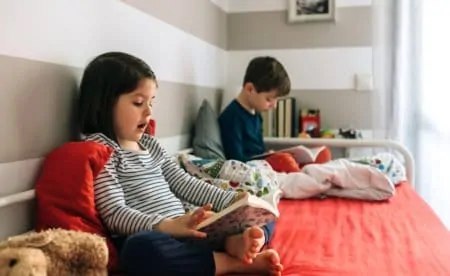Reading fluency is the bridge between decoding words and understanding a story. When kids struggle with fluency, they spend so much mental energy sounding out letters that they miss the meaning of the text.
The good news? You can fix this at home. We curated a list of creative, high-impact activities designed to boost speed, accuracy, and expression. From interactive games to theater techniques, these methods turn stumbling readers into confident storytellers.
Key Takeaways
- Model fluent reading by reading aloud to your child daily.
- Use “Echo Reading” and “Choral Reading” to build rhythm and confidence.
- Turn practice into play with games like “Oh Snap” and “Go Fish.”
- Focus on expression and phrasing, not just reading speed.
What Is Reading Fluency?
Reading fluency is more than just reading fast. It is the ability to read accurately, at a conversational pace, and with the right emotion (1).
Think of it like music. A fluent reader doesn’t just hit the right notes (accuracy); they play the song with rhythm and feeling. To be considered fluent, a child must:
- Read words correctly without stumbling.
- Decode unfamiliar words automatically.
- Pause at commas and stop at periods.
- Group words into phrases rather than reading robotically.
- Match their tone to the story, like excitement or sadness.
Why Is Reading Fluency Important?
Fluency is the key that unlocks comprehension. If a child reads slowly and halts often, their brain is too busy decoding to understand the plot.
Unfortunately, the numbers show we have a gap to close. According to the U.S. Department of Education, roughly two out of three 4th graders are not fluent readers (2).
The long-term risks for children who don’t master fluency by late elementary school are concerning:
- They are four times more likely to drop out of high school.
- They often struggle with other subjects, like science and history, because the textbooks are too hard to read.
There is a silver lining. Helping your child catch up doesn’t require hours of drilling. A study on struggling third-grade readers found a simple solution:
- Students who reached grade-level fluency simply read a few minutes more per day than those who didn’t (3).
- The magic number seems to be around 20 minutes of reading daily.
What Causes Poor Reading Fluency?
There isn’t one single culprit for choppy reading. It is usually a mix of factors.
Lack of Explicit Instruction
We often teach kids how to read (phonics), but we forget to teach them how to sound when they read. Without modeling, kids don’t learn prosody, which is the musical side of speech (4).
If a child never hears fluent reading, they won’t know how to mimic it.
Limited Vocabulary
If a child has to stop and figure out the meaning of a word, it breaks their flow. Children exposed to fewer books early on may have a smaller “sight word” bank. This forces them to decode almost every word they see, which slows them down significantly.
Processing Issues or Disabilities
Some children have learning differences, such as dyslexia or processing speed deficits. This has nothing to do with intelligence (5).
Think of it like driving a car. Some kids are on a highway; others are on a bumpy dirt road. They can both get to the destination (comprehension), but one requires a different vehicle and a bit more time.
Anxiety and Stress
If reading is always a struggle, a child will tense up. This anxiety creates a mental block. They focus so hard on not making a mistake that they lose the natural rhythm of the text.
Signs Your Child Is Struggling
How do you know if it is a fluency issue versus a comprehension issue? Look for these signs (6):
- Reading sounds choppy, robotic, or monotone.
- They ignore punctuation marks (reading through periods).
- It takes them a long time to finish a short page.
- They move their lips while reading silently.
- They can sound out the words but can’t tell you what happened in the story.
Best Reading Fluency Activities
You don’t need to be a teacher to use these methods. These are proven strategies used in classrooms that are easy to replicate in your living room.
1. Model Fluent Reading
The single most effective tool is your own voice. Reading to your child shows them what fluency sounds like.
Sit together. As you read, slide your finger under the text. Exaggerate your expression. If a character is angry, growl. If they are happy, pitch your voice up.
This takes the pressure off your child. They can enjoy the story without the work of decoding. Whether your child is a toddler or 10 years old, hearing a story read well is invaluable.
2. Audiobooks with Text Tracking
Audiobooks are a fantastic cheat code for fluency. They provide a perfect model of pacing and intonation.
The trick is to have your child follow along in the physical book while listening.
- Listen first: Let them listen to a chapter while looking at the words.
- Read after: Once they know how the narrator says the words, have them try reading that same chapter aloud to you.
- Record it: Record your child reading and let them listen to it. Compare it to the audiobook to see where they can improve.
3. Echo Reading
This is a low-stress method that builds immediate confidence. You read a sentence (or a short paragraph), and your child reads the exact same sentence back to you.
They are essentially mimicking your speed and phrasing. It acts like training wheels for their voice. Once they get the rhythm, you can switch to taking turns reading pages.
4. Choral Reading
If your child is shy or self-conscious, try Choral Reading. In this activity, you read the text aloud at the same time as your child.
Your voice acts as a guide. If they stumble on a word, your voice keeps going, pulling them along. It prevents them from getting stuck and frustrated. This works best with poems or rhyming books like Dr. Seuss.
5. Phrased (Scoop) Reading
Robotic reading happens when kids look at one word at a time. Phrased reading teaches them to look at groups of words.
Grab a marker and a copy of a text. Draw “scoops” under natural phrases.
- “The big red dog / ran down the street / to catch the ball.”
Have your child read the text by following the scoops. This visual cue forces them to pause only where it makes sense. Short poems are perfect for this exercise.
6. Repeated Reading
It sounds boring, but repetition is magic for the brain. Have your child read the same short passage (about 100 words) multiple times.
- Round 1: They work hard to decode the words. It might be slow.
- Round 2: They recognize the words faster. Speed increases.
- Round 3: They aren’t decoding anymore; they are comprehending. Now they can add expression.
Keep it positive. Frame it as “training” or “rehearsal” rather than a chore.
7. Reader’s Theater
Reader’s Theater turns reading into a performance. You don’t need costumes or props; you just need a script.
Assign roles to family members. The goal isn’t to memorize lines but to read the script with as much drama and character voice as possible. Because they are “acting,” kids forget they are reading. They focus entirely on the emotion, which naturally fixes their phrasing and speed.
Fun Reading Fluency Games
If drills feel too much like school, switch to games. Gamification removes the stress and makes practice feel like play.
1. Oh Snap!
This is a high-energy game for practicing sight words (words that defy phonetic rules and must be memorized).
Supplies: Popsicle sticks, a marker, and a cup.
- Write a sight word on one end of each stick.
- On three sticks, write “Oh Snap!”
- Put all sticks in the cup, words down.
How to play:
Take turns pulling a stick. If you can read the word, keep the stick. If you pull an “Oh Snap!” stick, you have to put all your collected sticks back in the cup. The player with the most sticks at the end wins.
2. Swat The Sight Word
Kids love this because they get to hit things.
Supplies: Index cards, marker, two fly swatters.
- Write target words on index cards and spread them out on the floor or table.
- Call out a word.
- The first player to slap the correct card with their fly swatter keeps the card.
This builds “automaticity,” which is the ability to recognize a word instantly without sounding it out.
3. Go Fish (Fluency Edition)
Use the classic card game rules but swap the standard deck for index cards with sight words written on them.
Setup:
Create pairs of word cards (two cards that say “said,” two cards that say “could,” etc.). Deal 5 cards to each player.
Gameplay:
Player A asks, “Do you have the word because?” They must read the word on their card to ask for the match. If Player B has it, they hand it over. If not, they say, “Go fish!”
The winner is the person with the most matched pairs.
Quick Tips for Parents
- Read the World: Don’t limit reading to books. Read cereal boxes, road signs, and menus. It shows that reading is a real-world skill.
- The 5-Finger Rule: To find a “just right” book, have your child read one page. If they miss more than 5 words, the book is too hard for fluency practice. Pick something easier to build confidence.
- Wait Time: If they stumble on a word, count to three in your head before jumping in. Give them a chance to self-correct.
- Focus on Content: Occasionally ask, “Why did the character do that?” This reminds them that the goal is understanding, not just finishing the page.






